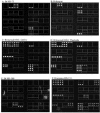Assessment of cry1 gene contents of Bacillus thuringiensis strains by use of DNA microarrays
- PMID: 16151129
- PMCID: PMC1214684
- DOI: 10.1128/AEM.71.9.5391-5398.2005
Assessment of cry1 gene contents of Bacillus thuringiensis strains by use of DNA microarrays
Abstract
A single Bacillus thuringiensis strain can harbor numerous different insecticidal crystal protein (cry) genes from 46 known classes or primary ranks. The cry1 primary rank is the best known and contains the highest number of cry genes which currently totals over 130. We have designed an oligonucleotide-based DNA microarray (cryArray) to test the feasibility of using microarrays to identify the cry gene content of B. thuringiensis strains. Specific 50-mer oligonucleotide probes representing the cry1 primary and tertiary ranks were designed based on multiple cry gene sequence alignments. To minimize false-positive results, a consentaneous approach was adopted in which multiple probes against a specific gene must unanimously produce positive hybridization signals to confirm the presence of a particular gene. In order to validate the cryArray, several well-characterized B. thuringiensis strains including isolates from a Mexican strain collection were tested. With few exceptions, our probes performed in agreement with known or PCR-validated results. In one case, hybridization of primary- but not tertiary-ranked cry1I probes indicated the presence of a novel cry1I gene. Amplification and partial sequencing of the cry1I gene in strains IB360 and IB429 revealed the presence of a cry1Ia gene variant. Since a single microarray hybridization can replace hundreds of individual PCRs, DNA microarrays should become an excellent tool for the fast screening of new B. thuringiensis isolates presenting interesting insecticidal activity.
Figures




Similar articles
-
Identification of cry1I-type genes from Bacillus thuringiensis strains and characterization of a novel cry1I-type gene.Appl Environ Microbiol. 2003 Sep;69(9):5207-11. doi: 10.1128/AEM.69.9.5207-5211.2003. Appl Environ Microbiol. 2003. PMID: 12957903 Free PMC article.
-
Detection and identification of cry1I genes in Bacillus thuringiensis using polymerase chain reaction and restriction fragment length polymorphism analysis.Curr Microbiol. 2006 Jan;52(1):60-3. doi: 10.1007/s00284-005-0171-2. Epub 2005 Dec 26. Curr Microbiol. 2006. PMID: 16392002
-
Characterization of cry genes in a Mexican Bacillus thuringiensis strain collection.Appl Environ Microbiol. 1998 Dec;64(12):4965-72. doi: 10.1128/AEM.64.12.4965-4972.1998. Appl Environ Microbiol. 1998. PMID: 9835590 Free PMC article.
-
Evolution of Bacillus thuringiensis Cry toxins insecticidal activity.Microb Biotechnol. 2013 Jan;6(1):17-26. doi: 10.1111/j.1751-7915.2012.00342.x. Epub 2012 Mar 29. Microb Biotechnol. 2013. PMID: 22463726 Free PMC article. Review.
-
PCR-based identification of Bacillus thuringiensis pesticidal crystal genes.FEMS Microbiol Rev. 2003 Jan;26(5):419-32. doi: 10.1111/j.1574-6976.2003.tb00624.x. FEMS Microbiol Rev. 2003. PMID: 12586389 Review.
Cited by
-
Insights into the whole genome sequence of Bacillus thuringiensis NBAIR BtPl, a strain toxic to the melon fruit fly, Zeugodacus cucurbitae.Curr Genet. 2024 Aug 5;70(1):13. doi: 10.1007/s00294-024-01298-2. Curr Genet. 2024. PMID: 39101952
-
Whole Genome Sequencing Analysis of Bacillus thuringiensis GR007 Reveals Multiple Pesticidal Protein Genes.Front Microbiol. 2021 Nov 2;12:758314. doi: 10.3389/fmicb.2021.758314. eCollection 2021. Front Microbiol. 2021. PMID: 34795652 Free PMC article.
-
Sensitive detection of Bacillus thuringiensis Cry1B toxin based on camel single-domain antibodies.Microbiologyopen. 2018 Aug;7(4):e00581. doi: 10.1002/mbo3.581. Epub 2018 Feb 24. Microbiologyopen. 2018. PMID: 29476614 Free PMC article.
-
Identification of Bacillus cereus group species associated with food poisoning outbreaks in British Columbia, Canada.Appl Environ Microbiol. 2008 Dec;74(23):7451-3. doi: 10.1128/AEM.01284-08. Epub 2008 Oct 10. Appl Environ Microbiol. 2008. PMID: 18849447 Free PMC article.
-
Isolation and characterization of Bacillus thuringiensis strains native to Assam soil of North East India.3 Biotech. 2017 Oct;7(5):303. doi: 10.1007/s13205-017-0935-y. Epub 2017 Sep 9. 3 Biotech. 2017. PMID: 28944151 Free PMC article.
References
-
- Adang, M. J., M. J. Staver, T. A. Rocheleau, J. Leighton, R. F. Barker, and D. V. Thompson. 1985. Characterized full-length and truncated plasmid clones of the crystal protein of Bacillus thuringiensis subsp. kurstaki HD-73 and their toxicity to Manduca sexta. Gene 36:289-300. - PubMed
-
- Ben-Dov, E., A. Zaritsky, E. Dahan, Z. Barak, R. Sinai, R. Manasherob, A. Khamraev, E. Troitskaya, A. Dubitsky, N. Berezina, and Y. Margalith. 1997. Extended screening by PCR for seven cry-group genes from field-collected strains of Bacillus thuringiensis. Appl. Environ. Microbiol. 63:4883-4890. - PMC - PubMed
-
- Berry, C., S. O'Neil, E. Ben-Dov, A. F. Jones, L. Murphy, M. A. Quail, M. T. G. Holden, D. Harris, A. Zaritsky, and J. Parkhill. 2002. Complete sequence and organization of pBtoxis, the toxin-coding plasmid of Bacillus thuringiensis subsp. israelensis. Appl. Environ. Microbiol. 68:5082-5095. - PMC - PubMed
Publication types
MeSH terms
Substances
LinkOut - more resources
Full Text Sources
Miscellaneous

